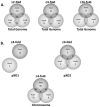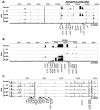Regulons and protein-protein interactions of PRD-containing Bacillus anthracis virulence regulators reveal overlapping but distinct functions
- PMID: 29603836
- PMCID: PMC6167206
- DOI: 10.1111/mmi.13961
Regulons and protein-protein interactions of PRD-containing Bacillus anthracis virulence regulators reveal overlapping but distinct functions
Abstract
Bacillus anthracis produces three regulators, AtxA, AcpA and AcpB, which control virulence gene transcription and belong to an emerging class of regulators termed 'PCVRs' (Phosphoenolpyruvate-dependent phosphotransferase regulation Domain-Containing Virulence Regulators). AtxA, named for its control of toxin gene expression, is the master virulence regulator and archetype PCVR. AcpA and AcpB are less well studied. Reports of PCVR activity suggest overlapping function. AcpA and AcpB independently positively control transcription of the capsule biosynthetic operon capBCADE, and culture conditions that enhance AtxA level or activity result in capBCADE transcription in strains lacking acpA and acpB. We used RNA-Seq to assess the regulons of the paralogous regulators in strains constructed to express individual PCVRs at native levels. Plasmid and chromosome-borne genes were PCVR controlled, with AtxA, AcpA and AcpB having a ≥ 4-fold effect on transcript levels of 145, 130 and 49 genes respectively. Several genes were coregulated by two or three PCVRs. We determined that AcpA and AcpB form homomultimers, as shown previously for AtxA, and we detected AtxA-AcpA heteromultimers. In co-expression experiments, AcpA activity was reduced by increased levels of AtxA. Our data show that the PCVRs have specific and overlapping activity and that PCVR stoichiometry and potential heteromultimerization can influence target gene expression.
© 2018 John Wiley & Sons Ltd.
Figures









References
Grants and funding
LinkOut - more resources
Full Text Sources
Other Literature Sources
Miscellaneous

